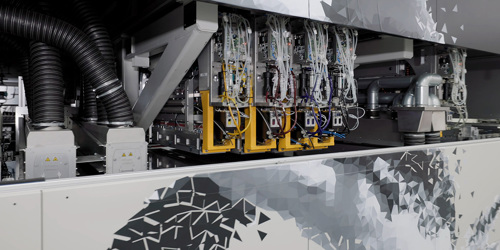Around 30 hand-picked customers from around the world saw the press printing at its top speed of 150m/min, or the equivalent of 11,000sph at the Inca facility, now rebranded as Agfa.
UK and Ireland customers in attendance included DS Smith, Delta Group, Simpson Group and McGowans.
The core target market for the SpeedSet is folding cartons, although Matt Brooks, head of packaging at Agfa’s Digital Print Solutions business, pointed out that its substrate versatility – from lightweight 0.2mm paper to 2mm microflute – widened its potential appeal.
He described the press as “robust and agile”, with “killer speed” and said it was built to last for at least 15 years.
“The first print is the right one,” he stated. “And we are able to run at these speeds consistently and reliably.”
“We focused on B1 folding cartons because B1 is the size needed for this market to adopt digital. The SpeedSet fits into the existing process.
“SpeedSet customers can consider replacing multiple devices, and it is opening up some conversations about multiple equipment replacement,” he added.
Arnaud Calleja, vice president for Digital Printing Solutions, told Printweek that pricing will depend on configuration but is likely to be €5m-plus (£4.3m). Ink will be sold as a consumable.
“This really is a milestone day for us,” he said.
“Our offering is based on four pillars: equipment, inks, software and service. We are not just providing equipment, we are providing a full solution.
“This is something that is differentiating us in the market and something our customers value because they have one point of contact.”
He said the pipeline of potential SpeedSet customers was already growing.
Modular device
The SpeedSet is a modular device, configured with a Mabeg feeder and stacker, and Natgraph hot air dryer.
The alpha press being demonstrated will remain in Cambridge, with two beta units under construction and set to be installed at customers in the UK and US next year.
It is an all-digital press, featuring inkjet primer, four colour CMYK inkjet bars using 25 Fujifilm Samba 1,200dpi printheads for each colour, then two inkjet varnishing bars.
Infra-red pinning takes place after priming and varnishing, with the warm air dryer after that.
Agfa has developed all the fluids and inks.
There is space for a further three print bars, such as orange, violet and green for extended gamut printing. White is under consideration.
The inks are water-based and comply with food safety regulations. Agfa will supply inks in 200-litre drums and is planning a return and refill system.
The patented transportation system involves a stainless steel belt that moves the sheets under the heads. A combination of a strong vacuum precisely where the sheet is, and positive airflow means that sheets float on a cushion of air yet also stick to the registration system.
The print bars move into place during printing, and then back into a docking area for the automatic cleaning process.
 Printheads in position for printing
Printheads in position for printing
Quality is described as “offset like” and the prints produced at the Cambridge demo looked impressive for an alpha device.
It is driven by Agfa’s Asanti production workflow.
The press is 25 metres long, 5m wide, and 3m high.
Agfa claimed the SpeedSet would have cost advantages over offset for runs of up to 5,000, and in some cases higher than that.
Quizzed about USPs over competing digital devices such as Landa’s S10 and the Koenig & Bauer Durst VariJet 106, Brooks cited the SpeedSet’s end-to-end speed and job handling, the substrate range, the fact that the press is fully digital, and the family of inks, primer and varnishes.
Shaping a new market
Speaking at a press briefing today (15 December) following the customer event, Agfa CEO Pascal Juéry said: “What you see today is the result of the combination of Inca into Agfa, and it is positioning us in a totally different place in the digital printing world.”
Agfa completed its acquisition of Inca 18 months ago.
“We are now recognised as one of the players that will help shape the market in digital printing. It’s not about doing ‘me too’, it’s about making markets and pushing digital in new territories, new markets, new geographies and new areas,” he stated.
“This is really the aim we have within Agfa.”
He described Agfa as “reapplying the core competences of the group” into new and attractive markets.
“We are still in the middle of the transformation, not everything is done, but I can tell you we have a group of people who are absolutely dedicated to make it happen.”
He also praised the “excellent” collaboration between Agfa’s teams in Belgium and Cambridge.
“We are a group in full transformation… what you are going to see today is a perfect example of what we are doing.”










